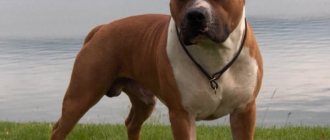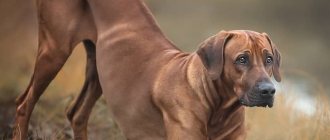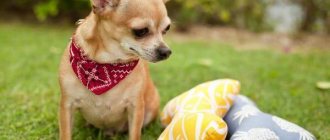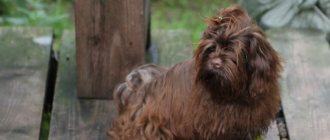| Origin: | Central Mediterranean |
| Usage: | companion, decorative dog |
| Color: | white |
| Dimensions: | 3-4 kg, 20-25 cm |
| Lifespan: | 12-15 years |
The Maltese is the oldest decorative dog. For her snow-white, flowing coat, her kindness and easy-going disposition, she is often called an angel. From ancient times to today, having a puppy of this breed is a sign of luxury and belonging to a noble class.
Exterior
The breed standard of the Fédération Cynologique Internationale (FCI) classifies the Maltese as a group of toy dogs, a subgroup of the Bichon and related breeds. In addition to the Maltese, this also includes Bolognese and Bichon Frize.
Photo of an adult Maltese dog.
Maltese dogs look charming, both in person and in photographs. These are miniature dogs with a snow-white coat that flows down the sides, black beady eyes and a charcoal nose. They have smooth, refined movements and the manners of aristocrats.
The table provides a detailed description of the breed.
| Parameter | Breed standard |
| Height | 21-25 cm males, 20-23 cm females. |
| Weight | 3-4 kg. |
| Constitution | Developed, dry, without roughness. |
| Frame | Stretched out, with a long straight back and a short arched loin. The neck is of moderate length and holds the head elegantly. The chest is voluminous, long, in circumference equal to 2/3 of the dog’s height. The stomach is slightly retracted. |
| Head | The length reaches more than half the height at the withers. Proportional, wide, ovoid, with a convex crown and nape. The forehead is divided in the middle by a hollow. |
| Ears | They stand high, hanging, if the dog is alert, they rise. In the shape of a triangle with round ends. Covered with long hair, which smoothly connects with the fur coat at the withers. |
| Eyes | Large, round in shape, set low and moderately deep. The color is dark brown, the edging is black. |
| Nose | Small, black. |
| Lips | Dry, thin, black mucous. The upper lip hangs over the lower lip. |
| Bite | Scissor-shaped. |
| Limbs | Straight, muscular, parallel when viewed from the rear or front. Stand clearly under the body, elbows pressed to the chest. |
| Paws | Small, collected in a round lump. Richly covered with wool. The pads and claws are strong and black. |
| Tail | Stands at the height of the back, thrown back and pressed to the body on the left or right. Equal to 60% of the dog's height, trimmed with straight, flowing hair. |
| Wool | Straight, long, reaches 22 cm, spreads along the ground. There is no undercoat. A mantle flows down the sides. The hairs on the head are the longest, blending in with the hair on the ears and face. |
| Color | White, less often - ivory. |
There are mini (toy) representatives weighing up to 2 kg. But they are not recognized by FCI, AKC and RKF.
Pros and cons of character
Malteses are the embodiment of love and tenderness. The highest happiness for them is to be close to their owner. And it doesn’t matter what a person is doing: playing, resting, working or cooking. Maltese dogs happily participate in any activity.
The Maltese not only has an angelic appearance, but also an angelic character. They are not prone to irritability, mood swings or grumpiness like other decorative breeds. Dogs pick up on people's moods and adapt to them.
Some Maltese dogs are moody. But this is the result of poor upbringing: overprotection and indulgence in whims.
Reviews from owners say that dogs catch thoughts. They understand when the owner is upset and predict what he is going to do.
Maltese love all family members and do not single out any one person. The disadvantages of the Maltese dog are that they are attached to people and cannot stand being alone. Sometimes this trait is developed to the point of neurosis: as soon as the pets are left alone, they begin to howl, whine and destroy the apartment. You cannot leave your pets alone for more than an hour.
Maltese dogs are playful and active. They delight in their “attacks of energy”: a couple of times a day, the dogs suddenly start rushing around or running in circles.
At the same time, Maltese dogs are not hardy. After wandering around for 5-15 minutes, they calm down and go to lie down on their favorite ottoman.
The Maltese has a weak nervous system. They are handled with care. Irritability and rudeness are unacceptable.
Nutrition
Feeding your Maltese requires special attention. There are quite a lot of diets and types of diets for the proper development and maintenance of the Maltese. Let us give one example recommended by Russian experts and breeders.
- Up to 6 months, experts recommend feeding puppies 4 times a day, p.
- after 6 – no more than 3 times,
- and adult dogs usually eat 2 times a day.
The recommended amount of food is 1 tablespoon per 500 grams of dog weight at one time.
The most suitable menu for a Maltese consists of small, high-calorie foods:
- Boiled or raw beef, boiled chicken, turkey, rabbit, fish.
- Fermented milk products must be included in a dog’s daily diet: fermented baked milk, kefir, yogurt, low-fat cottage cheese.
- Rice and buckwheat porridge, greens, dill, parsley, salad, chopped fruit.
- Finely chopped vegetables such as red bell peppers, cucumbers.
- It is useful to give chopped walnuts with a small amount (half a coffee spoon) of honey 2-3 times a week.
- Once a week you can give an egg yolk, which is best mixed with cottage cheese and seasoned with a teaspoon of olive oil.
You can easily create a daily menu from the above products, just keep in mind that Maltese are conservative eaters and willingly eat only those foods that are familiar to them.
Application
From the first day of its existence until today, Maltese dogs are exclusively companions. They were created to love and be loved.
At the same time, the Maltese breed demonstrates good watchdog and security qualities. Despite its tiny size, in case of danger the dog fiercely defends itself and its owner. True, not all pets have this trait.
It is worth considering that a small Maltese dog will not cope with protection. She can only bark or claw at an ill-wisher.
Moreover, pets sound the alarm for any reason. An unpleasant-smelling man passed nearby, the doorbell rang, they were shouting behind the wall, someone was climbing the stairs - and the Maltese immediately gave a voice. The dog should be weaned from excessive barking, otherwise complaints and complaints from neighbors will flow in a torrent.
A decorative dog is best suited for housewives, married couples, elderly people and all those who can and are willing to devote almost all their time to their pets.
Socialization
The main characteristic of the breed is the absence of anger. The Maltese is equally good with adults, children and pets.
This does not mean that the Maltese loves everyone. The most important thing for a dog is family. She perceives strangers and guests warily, with interest, but without aggression. The pet only allows family friends to play with him.
Dogs love children immensely and will never hurt them. You need to worry not about the kids, but about the Maltese - the latter often suffers at the hands of restless dogs.
Families with children under 10 years old are not recommended to have animals. Delicate and fragile Maltese dogs must be handled with care. Extremely careful. Even just by squeezing or dropping the dog, the baby will injure him.
Maltese dogs live in perfect harmony with other pets. Whether it’s a St. Bernard, a cat, a hamster or a parrot, the dog is non-confrontational and is friends with everyone.
Training and education
If you praise and delight your dog with treats, it will do everything to please its owner. Maltese dogs are very trainable dog breeds. Some pets can be overly independent, but this can be easily dealt with if you use the right reward system for following commands. Once the dog understands that he will receive a treat for completing the task correctly, he will be even more diligent in fulfilling your requirements.
Small breed dogs should never be oppressed or subjected to excessive persistence, much less aggression. This can lead to aggression on the part of the animal. Harsh treatment or physical punishment will cause distrust and internal protest, as well as a special distrust of people.
The main rule during training is rewarding for obedience and ignoring disobedience. Most experts are inclined to believe that training Maltese dogs should begin at the age of six to eight months. At the same time, some dog breeders begin this process almost from the first days the dog appears in the house.
Upbringing
The characteristics of the breed are such that in the classical sense, training a Maltese is not necessary. However, education, good manners and knowledge of basic commands are necessary.
They begin to work with the animal as soon as the Maltese puppy crosses the threshold of the apartment. The new family member is shown a place, a toilet, given a “tour” of the rooms, and introduced to the household.
Maltese dogs are smart. They understand on the fly what is wanted from them and what behavior is undesirable. The owners note that the dogs go to a diaper or in a basin within 2-3 days, and stop mischievousness after the first reprimand. Although some pets are stubborn and capricious.
Severe punishments are prohibited - a condemning (but not loud!) voice will suffice. And puppies up to 3-4 months are not scolded at all.
The Maltese dog is accustomed to a nickname, commands “Fu”/“No”, “Come to me” at 2-3 months. From 4 to 6 months, the remaining orders from the general training course are introduced - “Lie down”, “Sit”, “Stand”, “Nearby”, etc.
Maltese dogs don't need anything more. But they are taught tricks if they wish. For pets, this is a game and a way to spend time with the owner. They “die” with pleasure, bring newspapers and slippers, dance, etc.
Features of maintenance and care
Caring for and maintaining a Maltese dog is complex. True, you can even have a dog in a one-room apartment: the pet will only need a cozy place away from drafts and heating radiators, a couple of bowls and a few toys.
Maltese dogs should not be kept in the yard. This is a decorative, fragile dog that needs comfort.
But maintaining a luxurious Maltese coat in perfect condition is a problem. The saying “beauty requires sacrifice” fully characterizes the care of the Maltese. True, it will still take a lot of time, money and effort.
Wool grooming
It is possible to care for a Maltese at home. But you should prepare for the fact that all your free time will be spent on your dog. This is the main disadvantage of the breed.
The main problem is the fur coat. White wool requires regular washing, combing and trimming.
Grooming depends on the age of the Maltese:
- from 3 to 8 months, Maltese puppies are dressed in “baby fluff”; all they need is daily brushing;
- from 8 to 12 - 15 months, the fur coat is changed to an adult one - so that the hairs are renewed faster, the pet is combed 2-3 times a day, the long grown hair is put into curlers, thereby protecting it from dirt and damage;
- at 12-18 months the coat is completely renewed - it is constantly put into curlers, trimmed, and given the first haircuts.
The Maltese coat has no undercoat, does not shed and is hypoallergenic. But it is problematic to care for. Need to:
- comb the Maltese dog every day to prevent tangles - use several combs with teeth of different lengths and frequencies, massage brushes, antistatic sprays that untangle the hairs;
- cut out tangles if they have formed;
- collect long hair on the head into a tight bun using an elastic band or hairpin so that it does not get into the eyes or cover the muzzle.
Haircuts are a different story. They are done every 2-3 months in a pet salon, trimming regrown hairs. The classic Maltese hairstyle is a long, flowing coat, parted down the back from the neck to the tail. In addition, the hair between the toes and around the anus is trimmed.
For an exhibition career, only a classic haircut is suitable. Dogs that do not participate in competitions can be cut like a puppy - this will make grooming easier.
They also resort to original hairstyles - like a lion or a poodle. The photo of such dogs looks original, but haircuts are not provided for by the Maltese standard.
Bathing
Caring for and maintaining a Maltese is impossible without regular washing. Bathe your pet once every 7-10 days. And if it gets dirty, then more often, but no more than 2 times a week.
For bath procedures you will need:
- hypoallergenic shampoo for decorative breeds with long hair;
- balm or conditioner for rinsing;
- detangling spray;
- oils for wool.
For pets with snow-white fur, some owners use whitening shampoos. But this cannot be done. Products dry out the skin and damage the fur coat - it loses its shine, becomes brittle and split.
Animals are washed from head to tail. They try to prevent water and foam from getting into their eyes and ears. After the bath, dry the dogs with a towel, dry them with a hairdryer at low temperature, comb them and put their fur in curlers.
Other care
Other care for the Maltese is not difficult. Need to:
- wipe your eyes from nitrous oxides with veterinary lotion - brown tracks form around them, which spoil the snow-white hairs; do not use herbal decoctions, because they color the wool;
- trim the Maltese's claws - care for them is carried out once every 2 weeks;
- brush your teeth twice a week;
- wipe your face after eating;
- remove traces of discharge around the genitals - they turn the hairs yellow.
Not all procedures can be done at home. So, when changing teeth, the “milk jugs” do not always fall out on their own. You will need the help of a veterinarian. It is also used when a dense yellow coating forms on the crowns - it can only be removed by professional cleaning.
Walk
The Maltese is a dog that does not need long, tiring walks. A leisurely walk for 15-30 minutes twice a day is enough for her. And in inclement weather, or when there is no time, you can stay at home. The pet will play at home and relieve itself in the diaper or in the cat litter box. This is one of the main advantages of the breed.
However, you cannot keep Maltese dogs in your apartment all the time. Walking in the fresh air contributes to the harmonious development of the skeleton, joints, and muscles; sunbathing maintains the beauty of the coat due to the production of vitamin D3. And visiting public places, playing, communicating with people, dogs and other pets is an important part of socialization.
The Maltese dog loves to go for walks. But he gets tired quickly. It will be enough for her to run and play for a short time. Afterwards she will ask to go home.
The best option is to take your pet out for 10-15 minutes in the morning to relieve itself. In the evening, it’s good to walk your Maltese dog for 30-60 minutes.
In frost and rain, the Maltese will need clothes and shoes. Choose waterproof products made from natural fabrics that are not electrified - otherwise the wool will get tangled.
Feeding
Maltese dogs eat little, but are whimsical in their diet.
A significant disadvantage is that Maltese dogs gain excess weight quickly. Faster than any other decorative breed. Therefore, doggies should not be overfed.
Plus, Maltese dogs are finicky. They are wary of unfamiliar food and beg for tidbits. Pets may refuse a healthy portion of porridge with meat and beg for cookies or cheese. You cannot follow the lead, otherwise problems with digestion and hair will arise.
Maltese dogs can be fed natural food or prepared food. The first type of nutrition is standard, consisting of meat, cereals, vegetables and dairy products. However, there are several features:
- the volume of each serving is 50 g per kilogram of weight;
- meat and by-products make up 50%, the remaining 50% is allocated to cereals, vegetables, fruits, dairy products, fertilizing;
- be sure to include vitamin and mineral supplements;
- It is useful to add greens, chicken or quail yolk with olive oil and cottage cheese, 1 tsp. chopped walnuts with honey.
When choosing dry food, take into account the Maltese dog's tendency to gain weight, allergies, gastrointestinal diseases, skin and coat problems. Therefore, they choose grain-free products (holistic class), lines for small breeds with low activity, brands for improving skin and coat.
Ready-made foods suitable for the Maltese lapdog include:
- Acana Heritage Small Breed Grain Free for puppies;
- Guabi Natural for miniature breed puppies;
- Grandorf 4 Meat & Brown Rice Hypoallergenic for adult toy dogs;
- Barking Heads "Tiny Paw's Bad Hair Day" Adult Lamb;
- 1st Choice Dog Adult Toy & Small Breeds Healthy Skin & Coat Lamb & Fish.
Maltese eyes are indicators. They determine whether the food is suitable or not. If they don't eat properly, they water profusely.
Caring for a Maltese
The Maltese needs careful care from puppyhood. You should give your puppy a cozy place in the house without drafts. Even at such a young age, kids frolic for an hour and then rest for the same amount after playing. It is better to walk an active and nimble puppy on a leash so that he cannot run away. The thick and long coat of the Maltese requires constant care. She needs to be bathed promptly and brushed daily. You should not allow the fur to become matted, otherwise it will be difficult to comb out. Periodically, you should give your dog a haircut and different hairstyles as desired.
When bathing, you need to use special products so that the coat can be combed easier and look well-groomed. It is best to dry immediately with a towel and then with a low-heat hair dryer. The Maltese's eyes often water, causing brown streaks to appear. You can avoid such problems by wiping your dog’s eyes with a napkin soaked in clean bottled water.
The lapdog's claws need care; they should be cut with a nail clipper and filed with a nail file once every 2 weeks. The breed is considered to be easy to care for. She feels great in a small apartment and in a large country house. By paying her due attention, the dog will quickly settle into the family and will soon become a real little friend with a big and devoted heart.
Health
The Maltese breed developed naturally. Therefore, she is strong, healthy, with a strong genotype. On average, dogs live 14-16 years.
How long a Maltese dog lives is influenced by genetic inheritance and living conditions. If the pet is free of congenital defects and is well cared for, it can celebrate its 18th birthday. Otherwise, Maltese do not live long - sometimes they do not even reach 10 years.
Diseases
The Maltese dog breed has strong immunity and developed bones. But they have poor thermoregulation, so the breed is susceptible to overheating, frostbite and colds.
How long a Maltese dog lives depends greatly on the presence of diseases - congenital or acquired. Decorative dogs have:
- dislocations;
- heart disease;
- gastric stenosis;
- low blood sugar;
- hydrocephalus;
- dermatitis;
- glaucoma;
- retinal atrophy;
- clogging of tear defects;
- congenital deafness or blindness;
- disorders of the gastrointestinal tract.
It is important to ensure that the Maltese does not jump from surfaces higher than 30 cm. Otherwise, fractures, dislocations and bruises are inevitable. They are also prohibited from going up and down the stairs themselves.
Vaccinations
Vaccination of Maltese puppies is the main prevention of infectious diseases.
Vaccination schedule by month:
- at 2 months – the first serum against plague, bordetellosis, parainfluenza, hepatitis, parvovirosis;
- at 3 months - repeated injection against the same viruses;
- at 4 months or six months – rabies vaccination;
- at 12 months – comprehensive vaccination against rabies and other infections;
- every year – vaccination against all viruses.
Only healthy dogs are vaccinated. Before vaccination, animals are treated against blood-sucking parasites and worms.
Development of cubs by month
Maltese grow quickly and by six months they almost reach the size of an adult dog. The harmonious development of a puppy is the key to a healthy and long life.
There are no strict height and weight parameters for each age of the Maltese. Focuses on the general requirements for decorative breeds. The table below contains them.
| Month | Birth weight in g | ||
| № | 145 | 160 | 170 |
| 1 | 255 – 540 | 270 – 595 | 285 – 560 |
| 2 | 625 – 825 | 680 – 940 | 740 – 1050 |
| 3 | 910 – 1250 | 995 – 1390 | 1080 – 1525 |
| 4 | 1335 – 1620 | 1475 – 1760 | 1620 – 1900 |
| 5 | 1705 – 1875 | 1845 – 2045 | 1990 – 2200 |
| 6 | 1930 – 2100 | 2100 – 2280 | 2230 – 2500 |
| Adult dog | 2500 | 2800 | 3000 |
Note. Maltese puppies should gradually gain weight each month. For example, in the 1st week of the 1st month they will weigh 270 g, and in the 4th week - 595 g.
Is it worth getting a Maltese: advantages and disadvantages
Before getting a dog, you should weigh all the pros and cons of a Maltese. A dog has many advantages, but no less disadvantages.
| Maltese: pros and cons of the breed | |
| Advantages | Flaws |
| High adaptation to the conditions and lifestyle of the owner | Weak, easily excitable nervous system |
| "Amicability" with children and pets | Fragility - you can harm the dog by accidentally pushing or stepping on it |
| Playfulness | Large expenses for clothing and grooming items |
| Devotion | Difficult care |
| Lack of aggression and dominance | Tendency to manipulate |
| Ability to capture people's moods | Noisy, frequent barking for no reason |
| Hypoallergenic | Requires constant attention |
| Low food expenses | Picky eating |
| Cleanliness | Tendency to obesity |
| No need for long walks | With shortcomings in upbringing, behavioral problems and neuroses develop |
When choosing a Maltese, the pros are often considered, but the cons are forgotten. But it’s worth considering both sides – not everyone can take care of a dog around the clock.
Character
pros
and the disadvantages of the breed are the following features of its character.
- The Maltese is dependent on its owner and is attached to all members of his family.
- She loves children, enjoys playing outdoor games and chasing balls.
- Easy to train and remembers commands the first time. Lapdogs perform in circus arenas as they can easily perform the most difficult tricks.
- An inventive dog will not get bored alone and can easily turn a room into a playground. He will jump on the furniture and have fun with the owner's slippers.
- Gets along well with other pets. Loves to play with cats and other small dogs. But she won’t run to catch up with a cat she doesn’t know on the street.
- He is not aggressive towards strangers, but is very suspicious. He will not flatter or greet a stranger until he makes friends with him. Expresses dissatisfaction with loud barking and growling.
- If you show aggression towards the dog or owner, despite its small size, it may bite.
- Suitable for keeping in a small apartment and easily trained to go to the toilet using a disposable diaper or a special tray.
- One of the cleanest breeds.
- The breed is not aggressive towards other dogs, but due to its small size, the breed should be protected from contact with large dogs.
- The breed is playful and temperamental and can easily get underfoot. The animal should be constantly monitored.
- One of the most capricious breeds in food and grooming.
- Not suitable as a security guard and will not be able to protect the house.
Mating
Maltese dogs mature and grow physiologically quickly. The first heat in bitches occurs at 6–7 months, less often at 10–12 months.
However, Maltese dogs are untied no earlier than 15 months, or on the third heat. The latter are repeated every six months. But you can’t “force” a dog to get pregnant so often. According to generally accepted rules, the next mating is carried out on the second heat after birth.
Childbirth in Maltese dogs is usually trouble-free. A doctor's intervention is not needed, but the owner's help is required: he accepts the puppies and monitors the condition of the bitch. She gives birth to 2 to 5 puppies.
How to choose a puppy
Due to the high cost of dogs, the Maltese breed is not as common as other decorative dogs. This is a plus - there is less risk of stumbling upon an unscrupulous breeder selling sick or puppies that do not meet breed requirements.
Maltese puppies: photos.
However, scammers are everywhere. Therefore, before buying a Maltese dog you need to:
- check the pedigrees of the producers and the metrics of the Maltese puppy;
- look at the parents (at least the bitch) live;
- examine the Maltese puppies - they should be healthy, playful, not afraid of extraneous, loud sounds;
- Take a dog handler or an experienced breeder with you - they will determine how well the kittens’ exterior meets the standard requirements.
Babies have short fur - it will grow back later. Also, a Maltese puppy may have a wavy (but not curly!) coat - it will straighten out over time.
The Maltese is an elite dog. If the owner plans to engage in breeding, you need to seriously approach the choice of a sire - a male or a female. They pay attention to genetic data, certificates and awards, and breed qualities.
History of the origin of the breed
Maltese Scientists claim that the Maltese (another name for the lapdog) is one of the oldest breeds. Charles Darwin established that its first representatives appeared in the 6th century BC. This information is confirmed by ancient Greek paintings on vases, which depict dogs surprisingly similar to Maltese dogs. In manuscripts, the dogs were originally called Melite, after the island of Melita (present-day Malta).
But there are also opinions that the breed was brought to the island by merchants from Europe or China. It is known that the sweet and cheerful Bolonka immediately gained popularity in aristocratic circles. The presence of a dog of this breed in the house indicated the high status and sufficient financial position of the owner, along with silks and jewelry. Most often, ladies got a compact, snow-white dog, carrying it in their hands or baskets.
The breed was brought to England only in 55 BC. legionnaires and traders from Rome. The first exhibition took place in 1862. The most worthy representatives of the breed were in France at the end of the 19th century. Royalty, such as Queens Mary Stuart and Victoria, adored the Maltese and enjoyed showing them off to the public, after dressing the dog in expensive clothes and jewelry. The high popularity of the Maltese breed gave impetus to the development of specialized nurseries that have been striving for an impeccable gene pool for decades.
But that's not all. If there is demand, there will be supply. The noble lady was not distinguished by great physical strength and, of course, she wanted to reduce the weight of her favorite, who was pulling her hand during a social event. Well, if so, individuals of small size and lighter weight were most valued. These were the ones that were selected for further breeding. Moreover, after several generations, ultra-small dogs were bred, which were no longer deliberately crossed with representatives of the standard Maltese breed. Such individuals cost three or more times more, which means they were a more prestigious option than the standard Maltese.
They had a height of 15 to 20 centimeters and a weight of 1.5 - 2.5 kilograms. Males, of course, were a couple of centimeters taller than females. This is how a separate branch of the breed was developed - the Maltese mini.











